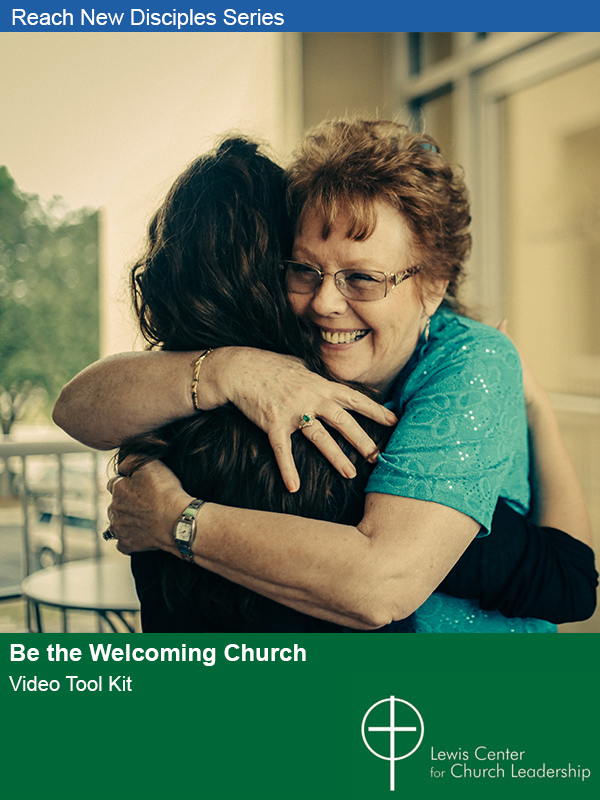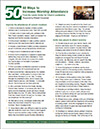Vital worship strengthens other areas of ministry by inspiring faith, building community, and connecting people to the congregation’s mission. Because worship is at the center of congregational life, strong attendance is more than a number. It is a vital sign.
Prepared by Robert Crossman
Improve the attendance of current members
- Strive to increase the number of times current members are in worship each year. Start with yourself.
- At least once or twice each year, perhaps in the New Year’s resolution season, teach and preach the importance of faithful worship attendance.
- Invite church members to make a written commitment to grow one step toward faithful attendance.
- Include a commitment to faithful worship attendance as part of a holistic annual stewardship commitment.
- Keep a record of attendance and monitor it.
- Know that it is important to respond to absentees before they drop out of active attendance. Once a regular attender misses six consecutive weeks, it is hard to return to the habit of consistent Sunday worship.
- Form a worship membership care team to review attendance within 24 hours of each service.
- Send a handwritten note (signed by the membership care team, not the pastor) to anyone who has missed three Sundays in a row. Say, “Looking through the attendance slips, we’ve missed your name! Hope to see you next Sunday.” In a smaller church, the wording can be more personal.
- Ask a personal friend (a choir mate, Sunday School class member, or someone who sits in the same pew) to telephone people who have missed four Sundays in a row. “Hi John. We’ve noticed that Fred has missed church the last four Sundays. Can you telephone him this evening?”
- Maintain a loving, invitational relationship with those who have been absent for five or more Sundays. Never be judgmental.
- Know that is often very difficult to return to worship after the death of a loved one. Form a Grief Support Team to send handwritten notes monthly until the family has returned to regular Sunday attendance.
- Telephone every household in the church and everyone who has ever visited to invite them to some special event four times a year. Say, “Hi, we are calling everyone related to First Church this week, reminding everyone that this Sunday the choir is singing the Messiah. I hope you will be there.”
Invite new people to attend worship
- Decide today to open your minds, hearts, and doors to new faces, even if it means changing your music, sermon content, Sunday School, and enlarging your personal circle of Christian friends.
- Pray for the unchurched in your community. Pray for children being raised outside the church, couples in marriages that don’t have Christ at their center, etc. But pray also for specific families and individuals — friends, relatives, associates, neighbors — by name every day.
- Know that personal invitations are the most effective method of increasing worship attendance. Invest 60 seconds once a week to invite someone to attend worship with you.
- Continue to invite a person every two months even if they decline your invitations. Those invited may eventually come to a season of life when they are receptive to attending worship. Regular invitations are more likely to overlap one of these seasons.
- Recycle your worship bulletins. Keep Sunday’s bulletin in your car or on your desk until you have given it to someone along with your personal invitation for them to join you in worship.
- At least once a year, perhaps in the pre-Christmas season, preach and teach the importance of becoming an inviting people. Invite the congregation to make a written commitment to grow one step toward faithful inviting and witnessing.
- Distribute to members simple printed invitations during the Christmas and Easter seasons that they can give to family and friends. Print at the top of the card, “If you are not active in a church, worship with us this season.”
- Have a “Bring a Friend Day” or “F.R.A.N.” Day — a church-wide effort to bring a Friend, Relative, Associate or Neighbor. Select a Sunday when something special is happening, such as homecoming, the start of Vacation Bible School, or Christmas Eve. And prepare as you would for company coming.
- Know that the people who are on the fringe of your church are your future, your prospect list, and your next potential generation of deeply devoted disciples. Avoid the tendency to denigrate or alienate those who are not yet fully committed disciples.
- Find ways continually to invite these “near the edges” of your church, especially those who already have a positive impression of the church, such as those who have come to the church for a wedding, a funeral, or to vote and those who already worship a couple of times a year. Do not drop them from the newsletter or membership list.
- Distribute door hangers in target neighborhoods near your church. It is more effective to cover the same 500 doors six times, than to do 3,000 doors one time.
- Send mass mailers to targeted postal routes near your church six to eight times a year. The back-to-school season, pre-Christmas, and pre-Easter times are logical for these mailing.
- Have a website. Increasingly, people use the internet and Google the same way our grandparents used the Yellow Pages. The web presence can be very simple, a single page with a map, worship times, simple welcoming invitation, and contact information.
Make your church visible and attractive
- Purchase permanent roadside directional signs to point the way to your building. If your building is not on the main highway, install a prominent sign on the highway.
- Purchase temporary yard signs to put out for a few days and then remove. They catch the eye and are relatively inexpensive. They should be very simple with little wording, such as: “Worship 10 a.m. Sunday. You’re Invited.” “Easter Sunday 11 a.m. You’re Invited.”
- Don’t hide your cars. If there is parking in front of the building, use it. Cars in the parking lot lets the community know that something important is happening at your church.
- Make a good first impression through the appearance of your building and landscaping. A well cared for exterior lets guests know that you are expecting company.
- Clearly indicate the main entry to your building so that worship guests can find it easily.
- Reserve the best parking spaces for guests. The pastor, staff, and church officers should park on the edge of the parking lot, leaving the best spaces for others.
- Make the nursery the nicest room in the church to attract and keep families with young children. It should be clean and well equipped, in an easy-to-find location close to the worship space, and staffed with adults. As your church grows, you will need pagers, check in and check out procedures, and nursery staff wearing uniforms with a photo ID.
- Have clean, neat Sunday School rooms for children. The Sunday School program should be well-staffed and well-resourced.
Welcome worship guests warmly
- Greet guests when they first arrive in the parking lot. Give a couple of people orange vests and have them wave and smile as cars pull in. On rainy days, they can escort people to the door under a church umbrella. If the lot is large, they can drive folks to the door in golf carts.
- Greet guests as they arrive at the door, saying “Good to see you. Glad you are here.” Do not ask for their names as many guests are cautious and prefer anonymity. The larger the church, the more this is true.
- Clearly mark the rest rooms, nursery, and worship rooms. In a large building with a complicated layout, have greeters stand at the intersection of hallways ready to escort guests who are unsure about finding their way.
- Find a way to acknowledge and welcome guests in worship without singling them out or embarrassing them. In many communities, guests prefer to be anonymous so don’t ask them to stand and introduce themselves.
- Have an easy and readily available method for worship guests who wish to give you their name and contact information.
- Practice the “Circle of Ten.” Encourage church leaders to personally greet everyone — member or guest — who may sit within ten feet of them on Sunday.
- Know that guests typically leave the building within three minutes after the service. Encourage church leaders to follow the “Rule of Three,” devoting the first three minutes after the benediction to speaking with people they don’t know before speaking to family and friends.
- Have greeters at all the exits, smiling, shaking hands, and simply saying to members and guests as they leave, “Glad you were here. I hope to see you next Sunday.”
- Start a “First Friends” ministry as a way to reach a new age, racial, or cultural group. Train a pool of people, from a variety of ages and stages of life, to watch for first time guests, sit by them, treat them to lunch, and telephone them the next Saturday inviting them to Sunday worship.
Make worship accessible to newcomers
- Make your worship bulletin or screens visitor friendly. Include the actual words, or at least the page numbers, for any songs or responses commonly known to members but not newcomers.
- Preach sermons that don’t assume familiarity with the inner workings of the church or a high level of previous biblical knowledge.
- Present all musical offerings well and in a style most likely to appeal to worship guests.
- Consider adding an additional worship service to reach new people who would prefer a different time; or to reach new people who would prefer a different style of worship and music.
- Start a new church or a second worship site at a different location as a way of increasing attendance.
Follow up with visitors
- Develop a systematic plan for following up with visitors after their first, second, and third visits.
- One model some use includes 1) follow up with first-time visitors with a doorstep visit before 3 p.m. that same Sunday, a letter or telephone call from the pastor within two days, and placement on the newsletter and email lists; 2) follow up with second-time visitors with telephone call within 36 hours from someone related to the visitor’s interests or needs — for example, a Youth Minister, or Sunday School Teacher, or Choir Director; and 3) follow up with persons who visit a third time with a telephone call to request a home visit.
- Invite newcomers who have visited in recent months to an informal coffee with the pastor or other social gathering that includes fellowship and information.
Dr. Robert Crossman is Minister of New Church Starts and Congregational Advancement for the Arkansas Conference of the United Methodist Church. Used by permission.
Download a PDF of this page to share with others.

 Lewis Center video tool kit resource
Lewis Center video tool kit resource
Be the Welcoming Church
Learn how your church can make visitors feel truly welcome and comfortable!
The Be the Welcoming Church Video Tool Kit will help you develop a congregation-wide ethos of hospitality and institute best practices for greeting newcomers, making them feel at home, and encouraging them to return. The resource includes engaging videos, a Study and Discussion Guide, and more. Be the Welcoming Church may be used for hospitality training or in adult classes or groups. more. Learn more and watch introductory videos now.






